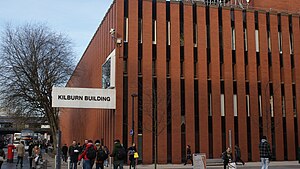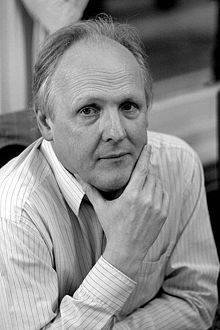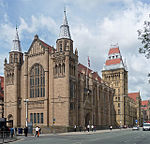School of Computer Science, University of Manchester
 | |
Former names |
|
|---|---|
| Established | 1964, with history back to 1947[1] |
| Head of School | Robert Stevens |
| Students | ~800 |
| Location | Manchester , United Kingdom Coordinates: 53°28′03″N 2°14′03″W / 53.4676°N 2.2343°W / 53.4676; -2.2343 |
| Affiliations | Faculty of Engineering and Physical Sciences, University of Manchester |
| Website | cs.manchester.ac.uk |
The School of Computer Science at the University of Manchester is the longest established school of Computer Science in the United Kingdom and one of the largest. It is located in the Kilburn building (and the attached IT Building) on the Oxford Road and currently has over 800 students taking a wide range of undergraduate and postgraduate courses and 60 full-time academic staff.
Contents
1 Teaching and study
1.1 Undergraduate
1.2 Postgraduate
2 Notable academic staff
2.1 Advanced Processor Technologies
2.2 Bio-Health Informatics
2.3 Formal Methods
2.4 Information Management
2.5 Machine Learning and Optimisation
2.6 Nano Engineering and Storage Technologies
2.7 Software Systems
2.8 Text Mining
2.9 Advanced Interfaces
2.10 Imaging Science
3 Management
3.1 Heads of School
3.2 Heads of Department
4 History
4.1 Alumni
5 References
Teaching and study

Professor Steve Furber FRS FREng works on the SpiNNaker and the Human Brain Project

Carole Goble CBE FREng is a Professor of Computer Science

Professor Robert Stevens has been head of school since 2016

Professor Ulrike Sattler research investigates knowledge representation and reasoning

Professor Ross D. King works on the Robot Scientist project

Tom Kilburn (1921-2001) was the first head of the school from 1964 until 1980

Alan Turing was deputy director of the computing laboratory, a predecessor to the School of Computer Science
Undergraduate
The School current offers a wide range of undergraduate courses from Bachelor of Science (BSc), Bachelor of Engineering (BEng) and Master of Engineering (MEng).[2] These are available as single honours or as joint honours degrees within the themes of Artificial Intelligence, Computer Science, Computer systems engineering, Software engineering, Mathematics, Internet Computing, Business applications and Management. Industrial placements are offered with all undergraduate courses.[2]
Postgraduate
At postgraduate level the school offers taught Master of Science (MSc) degrees, at an advanced level and also through a foundation route.[3] Research degrees, Doctor of Philosophy (PhD) and Master of Philosophy (MPhil) are available as three and four year programmes through the Doctoral Training Centre in Computer Science, the first of its kind in the UK.[4]
Notable academic staff
- Terri Attwood
- Andy Brass
- Jack Dongarra
- Steve Furber
- Carole Goble
- Ross D. King
- Jim Miles
- Norman Paton
- Allan M. Ramsay
- Robert Stevens
- Andrei Voronkov
The School is organised into nine different research groups which received funding from a wide range of sources including the European Union, Engineering and Physical Sciences Research Council and Biotechnology and Biological Sciences Research Council.
Advanced Processor Technologies
The Advanced Processor Technologies (APT) group researches advanced and novel approaches to processing and computation and is led by Professor Steve Furber. New projects include SpiNNaker, Transactional Memory, and TERAFLUX.[5] Academic staff in the group include Dr Nick Filer, Dr Jim Garside, Dr David Lester, Dr Mikel Luján, Dr John V Woods, Dr Javier Navaridas, Dr Vasilis Pavlidis, Dr Eva M. Navarro-López, Dr Dirk Koch, Dr Antoniu Pop and Emeritus Professor Ian Watson, visiting Professor Alasdair Rawsthorne[6][7] and Fellow Barry Cheetham.[5][8] Past research projects include Jamaica, AMULET microprocessor, Network On Chip, Asynchronous Digital signal processors and System on a chip.
Bio-Health Informatics
The Bio-Health Informatics Group (BHIG) conducts research in Bioinformatics and Health informatics ranging from the applications in molecular biology through to clinical e-science and healthcare applications. Academic staff in the group include Emeritus Professor Alan Rector, Professor Andy Brass and Robert Stevens.[9]
Formal Methods
The Formal Methods group has a very broad span of interests, ranging from developing the new mathematics of computational behaviour, to the study and development of system design and verification methods. There is a large group dedicated to the automation of logic including world-champion Vampire. The group is led by Professor Allan Ramsay and includes Professor Peter Aczel, Professor Andrei Voronkov, Professor Howard Barringer[10] amongst more than a dozen staff and a large number of research students.[11]
Information Management
The Information Management Group (IMG)[12] conducts basic and applied into the design, development and use of data and knowledge management systems. Such research activities are broad in nature as well as scope, including basic research on models and languages that underpins activities on algorithms, technologies and architectures. Challenging applications motivate and validate this research, in particular the Semantic Web and e-Science. Examples of recent research include Protégé, Utopia Documents, myGrid, Taverna workbench, myExperiment, Open PHACTS. Academic staff in group include Professor Carole Goble CBE, Professor Norman Paton, Professor Ulrike Sattler, Professor Robert Stevens, Sean Bechhofer, Andy Carpenter, Suzanne Embury, Alvaro A. A. Fernandes, Simon Harper, Bijan Parsia, Rizos Sakelloirou, Sandra Sampaio and Ning Zhang.[12]
Machine Learning and Optimisation
The Machine learning and Optimisation (MLO) group[13] conduct world-leading research into a wide range of techniques and applications of machine learning, optimization, data mining, probabilistic modelling, pattern recognition and machine perception. Academic staff include Jon Shapiro (group leader),[14] Professor Ross King, creator of Robot Scientist, Gavin Brown, Ke Chen, Richard Neville[15] and Xiaojun Zeng.
Nano Engineering and Storage Technologies
The Nano Engineering and Storage Technologies (NEST) group has research interests in nano fabrication for data storage and advanced sensors applications and the investigation of data storage systems in general. The NEST group is housed in an integrated suite of staff offices, general-purpose laboratory space and class 100/1000 cleanrooms and is a founder member of the Manchester Centre for Mesoscience and Nanotechnology where the ground-breaking, Nobel Prize–winning work on Graphene by Andre Geim and Konstantin Novoselov was undertaken. The group is led by Professor Thomas Thomson,[16] academic staff members include Professor Jim Miles, Ernie W Hill, Milan Mihajlovic and Paul W Nutter.
Software Systems
The Software Systems group[17] is concerned with the design, modelling, simulation and construction of mission-critical systems that challenge the states-of-the-art in both software engineering and performance engineering. Such systems are fundamentally composed of physically distributed component sub-systems, and are characterised by large data spaces and high compute needs, with associated complex interactions between the components. The group is led by Professor John Gurd,[18] academic staff members include Professor John Keane,[19] Len Freeman, Kung-Kiu Lau, Liping Zhao, Rupert Ford and Graham Riley.[17]
Text Mining
The Text Mining group[20] performs research to extract useful information and knowledge from unstructured text, particularly in the field of bioinformatics. The group also performs research into Natural Language Processing (NLP) and hosts the National Centre for Text Mining. The group is led by Professor Sophia Ananiadou[21] and includes academic members Professor Jun'ichi Tsujii, John McNaught and Goran Nenadic.[20]
Advanced Interfaces
The Advanced Interfaces Group (AIG)[22] researches virtual environments, collaborative visualization systems, and computer vision. The group is led by Steve Pettifer[23] and includes academic staff Professor Terri Attwood, jointly with the Faculty of Life Sciences, Aphrodite Galata, Toby Howard, Tim Morris, and Emeritus Professor Roger Hubbold.[24] Current projects include UTOPIA software.
Imaging Science
The Imaging sciences is part of the Centre for Imaging Sciences, a world-class research department focusing on imaging physics, image processing, computer vision, and the development and application of imaging biomarkers in healthcare. The group[25] is run by Professor Chris Taylor[26] jointly with the School of Medicine.[25] The group includes Dr Carole Twining and Professor Tim Cootes.
Management
The school (and department) has been led by ten different Heads of School since its inception in 1964.
Heads of School
The School has been run by
Robert Stevens from 2016 to date
Jim Miles from 2011 to 2016
Norman Paton 2008–2011- Chris Taylor 2004–2008
Heads of Department
Prior to merger with UMIST the School of Computer Science was the Department of Computer Science.
Steve Furber 2001–2004
Brian Warboys 1996–2001- Howard Barringer 1991–1996
- John Gurd 1987–1991
- Dai Edwards 1980–1987[27][28]
Tom Kilburn 1964–1980[29][30]
History
The school has its roots in the Computer Group of the Electrical Engineering Department at the Victoria University of Manchester. The Computer Group was established following Freddie Williams's move to the Electrical Engineering Department in 1946.[31] At its formation in 1964, the Department of Computer Science was the first such department in the United Kingdom, with Professor Tom Kilburn serving as Head of Department until 1980. On 1 May 2001, following the death of Kilburn the same year, the Computer Building was renamed Kilburn Building in his honour[32]. The School of Computer Science was formed from the Department when the Victoria University of Manchester and UMIST merged to form the University of Manchester in 2004. The Group/School/Department is notable for the following achievements:
- The world's first electronic stored-program digital computer (the Manchester Baby)
Virtual memory using paging (see Atlas Computer)- Manchester encoding
- The AMULET microprocessor series (asynchronous implementations of the ARM computer architecture)
See also the History of the school.[1] The following alumni have been staff in the School
Alumni
The school and department has several notable alumni including:
Ian Horrocks, FRS Professor of Computer Science at the University of Oxford
Hilary Kahn, a professor in the computer science department[33]
Tom Kilburn,[34] first head of the Department of Computer Science- Joshua Knowles, Professor at the University of Birmingham
Pedro Mendes, Professor at the University of Connecticut Health Center
- Magnus Rattray, Professor of Computational and Systems Biology in the Faculty of Life Sciences[35]
Alan Turing was a Reader in the Mathematics Department and was deputy director of the computing laboratory.- Professor Brian Warboys
- David Bree, Emeritus Professor of Artificial Intelligence[36]
Freddie Williams[37]
- Simon Lavington[38][39]
Geoff Tootill[40]
- Nandini Mukherjee
References
^ ab http://www.cs.manchester.ac.uk/aboutus/history/ History of the School of Computer Science
^ ab "Undergraduate Studies (School of Computer Science - The University of Manchester)". Retrieved 2012-07-24..mw-parser-output cite.citation{font-style:inherit}.mw-parser-output .citation q{quotes:"""""""'""'"}.mw-parser-output .citation .cs1-lock-free a{background:url("//upload.wikimedia.org/wikipedia/commons/thumb/6/65/Lock-green.svg/9px-Lock-green.svg.png")no-repeat;background-position:right .1em center}.mw-parser-output .citation .cs1-lock-limited a,.mw-parser-output .citation .cs1-lock-registration a{background:url("//upload.wikimedia.org/wikipedia/commons/thumb/d/d6/Lock-gray-alt-2.svg/9px-Lock-gray-alt-2.svg.png")no-repeat;background-position:right .1em center}.mw-parser-output .citation .cs1-lock-subscription a{background:url("//upload.wikimedia.org/wikipedia/commons/thumb/a/aa/Lock-red-alt-2.svg/9px-Lock-red-alt-2.svg.png")no-repeat;background-position:right .1em center}.mw-parser-output .cs1-subscription,.mw-parser-output .cs1-registration{color:#555}.mw-parser-output .cs1-subscription span,.mw-parser-output .cs1-registration span{border-bottom:1px dotted;cursor:help}.mw-parser-output .cs1-ws-icon a{background:url("//upload.wikimedia.org/wikipedia/commons/thumb/4/4c/Wikisource-logo.svg/12px-Wikisource-logo.svg.png")no-repeat;background-position:right .1em center}.mw-parser-output code.cs1-code{color:inherit;background:inherit;border:inherit;padding:inherit}.mw-parser-output .cs1-hidden-error{display:none;font-size:100%}.mw-parser-output .cs1-visible-error{font-size:100%}.mw-parser-output .cs1-maint{display:none;color:#33aa33;margin-left:0.3em}.mw-parser-output .cs1-subscription,.mw-parser-output .cs1-registration,.mw-parser-output .cs1-format{font-size:95%}.mw-parser-output .cs1-kern-left,.mw-parser-output .cs1-kern-wl-left{padding-left:0.2em}.mw-parser-output .cs1-kern-right,.mw-parser-output .cs1-kern-wl-right{padding-right:0.2em}
^ http://www.cs.manchester.ac.uk/postgraduate/ Postgraduate study in the School of Computer Science
^ "Manchester Centre for Doctoral Training in Computer Science". Retrieved 2012-07-25.
^ ab "Research Groups: APT - Advanced Processor Technologies (School of Computer Science - The University of Manchester)". Archived from the original on 2012-07-30. Retrieved 2012-07-24.
^ "Alasdair RAWSTHORNE born May 1953". companieshouse.gov.uk. London: Companies House. Archived from the original on 2016-08-03.
^ http://apt.cs.man.ac.uk/people/arawsthorne/ Professor Alasdair Rawsthorne
^ http://www.manchester.ac.uk/research/ian.watson Professor Ian Watson
^ "Bio-Health informatics Group Home". Retrieved 2012-07-24.
^ http://www.manchester.ac.uk/research/Howard.barringer/ Prof Howard Barringer - personal details
^ "Foundations and formal methods (School of Computer Science - The University of Manchester)". Archived from the original on 2012-03-29. Retrieved 2012-07-24.
^ ab "Information Management". School of Computer Science. University of Manchester. Retrieved 28 January 2015.
^ "mlo.cs.man.ac.uk". Retrieved 2012-07-24.
^ "Jonathan L. Shapiro Homepage". Retrieved 2012-07-24.
^
http://www.manchester.ac.uk/research/r.neville
^ http://www.manchester.ac.uk/research/Thomas.thomson/
^ ab "Research Groups: Software Systems Group (School of Computer Science - The University of Manchester)". Archived from the original on 2012-05-10. Retrieved 2012-07-24.
^ http://www.manchester.ac.uk/research/John.r.gurd/ Professor John R. Gurd
^ http://www.manchester.ac.uk/research/John.keane/ Prof John A. Keane - personal details
^ ab "Information Systems (School of Computer Science - The University of Manchester)". Archived from the original on 2012-05-29. Retrieved 2012-07-24.
^ http://www.nactem.ac.uk/staff/sophia.ananiadou/ Sophia Ananiadou, Professor in Computer Science, University of Manchester
^ "Advanced Interfaces Group". Retrieved 2012-07-24.
^ http://aig.cs.man.ac.uk/people/srp/ Prof. Steve Pettifer
^ "Archived copy". Archived from the original on 2013-06-26. Retrieved 2012-06-08.CS1 maint: Archived copy as title (link) Professor Roger Hubbold Homepage
^ ab "Imaging Sciences (Imaging Sciences Research - University of Manchester)". Retrieved 2012-07-25.
^ "Archived copy". Archived from the original on 2012-12-23. Retrieved 2012-06-08.CS1 maint: Archived copy as title (link) Professor Chris J. Taylor FREng, OBE
^ Anon (2010). "Dai Edwards: helping Turing use the Manchester Mark 1". www.bl.uk. British Library.
^ Anon (2014). "Voices of Science: David 'Dai' Edwards. Born David Beverley George Edwards, 1928". www.bl.uk. British Library. Archived from the original on 2014-01-16.
^ Kilburn, T. (1951). "The New Universal Digital Computing Machine at the University of Manchester". Nature. 168 (4264): 95. doi:10.1038/168095a0.
^ Lavington, Simon (2001). "Obituary: Tom Kilburn (1921–2001)". Nature. 409 (6823): 996. doi:10.1038/35059201. PMID 11241994.
^ "The University of Manchester celebrates the Birth of the Modern Computer". computer50.org. Archived from the original on 2012-05-04.
^ Duncan Hull (2007). "Tom Kilburn". Flickr.
^ "Professor Hilary Kahn (1943-2007)". digital60.org.
^ Kahn, Hilary J. (2004). "Kilburn, Tom (1921–2001), computer scientist". The Oxford Dictionary of National Biography. doi:10.1093/ref:odnb/55314.
^ http://www.ls.manchester.ac.uk/people/profile/?personid=10584
^ http://www.cs.man.ac.uk/~dbree/
^ Kilburn, T.; Piggott, L. S. (1978). "Frederic Calland Williams. 26 June 1911-11 August 1977". Biographical Memoirs of Fellows of the Royal Society. 24: 583. doi:10.1098/rsbm.1978.0020.
^ Lavington, Simon H. (1978). "The Manchester Mark I and atlas: a historical perspective". Communications of the ACM. 21 (1): 4–12. doi:10.1145/359327.359331.
^ Simon Lavington's publications indexed by the Scopus bibliographic database. (subscription required)
^ "Geoff Tootill: Born 1922 Lancashire, UK". www.bl.uk. British Library.
